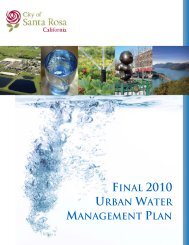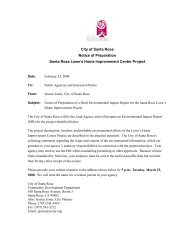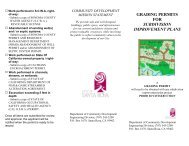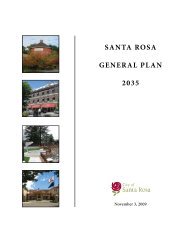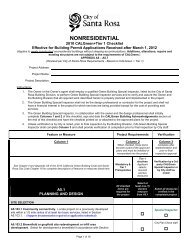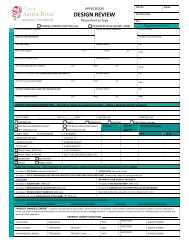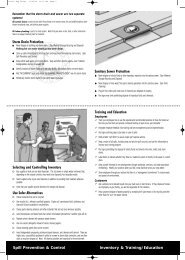Fountaingrove Environmental Impact Report - City of Santa Rosa ...
Fountaingrove Environmental Impact Report - City of Santa Rosa ...
Fountaingrove Environmental Impact Report - City of Santa Rosa ...
Create successful ePaper yourself
Turn your PDF publications into a flip-book with our unique Google optimized e-Paper software.
3.6 GEOLOGY, SOILS, AND SEISMICITY<br />
Active and potentially active faults within the Project site limits and immediate vicinity<br />
have been mapped and documented by a number <strong>of</strong> government agencies. The United<br />
States Geological Survey and CDMG have published numerous maps and reports on faults<br />
<strong>of</strong> various types, ages, and levels <strong>of</strong> activity. The faults nearest to the Project site are shown<br />
on Figure 3.6-3.<br />
Surficial Deposits. Soil deposits found onsite typically comprise a thin layer <strong>of</strong> brown,<br />
porous silt, surficial deposit overlying gravel, cobble, and occasional boulders. Over much<br />
<strong>of</strong> the Project site, a clayey soil was encountered beneath this gravelly deposit (Giblin, 2007).<br />
Slope-wash and ravine fill are classified as colluvial-type deposits, which consist <strong>of</strong> loose<br />
sediments at the foot <strong>of</strong> a slope brought there principally by gravity and slope wash.<br />
Substantial accumulations <strong>of</strong> fill were found in the drainage swales in the northern and<br />
south-central portions <strong>of</strong> the Project site (Giblin, 2006b). The existing fill appears to be<br />
related to past grading, filling, and stockpiling <strong>of</strong> materials in the drainage swales. The fill<br />
appears to be about 4 to 5 feet thick and consists <strong>of</strong> s<strong>of</strong>t to medium-stiff sandy clay with<br />
cobbles and occasional boulders. Laboratory tests indicated that the soils exhibit a moderate<br />
expansion potential (Giblin, 2006b).<br />
Below the existing fill deposits, natural sandy clays and sandy silts were found. These soils<br />
were observed to be porous, highly organic, and compressible. They generally exhibited a<br />
low to moderate expansion potential. In the swale areas onsite, sandy clays <strong>of</strong> high<br />
expansion potential were observed below the weak porous upper soils (Giblin, 2006b).<br />
Bedrock. Published maps indicated that rock in the Project vicinity comprises primarily two<br />
geologic units: the Miocene-Pliocene age sedimentary rocks <strong>of</strong> the Petaluma Formation and<br />
the Pliocene age Sonoma Volcanics (Giblin, 2006a). The Petaluma Formation includes poorly<br />
indurated to lightly cemented sandstone, siltstone conglomerate, mudstone, and claystone<br />
and is reported to include some tuffaceous and diatomaceous beds locally. The Petaluma<br />
Formation is considered highly susceptible to landslides and slope instability. Although<br />
published maps indicate that the Petaluma Formation is located west and beyond the<br />
Project site, volcaniclastic sedimentary rocks encountered in the 2006 geologic hazards field<br />
investigation by Giblin Associates could be interpreted to be part <strong>of</strong> the uppermost portion<br />
<strong>of</strong> the Petaluma Formation, as shown in Figure 3.6-4.<br />
Published maps and previous geologic work performed indicate that the bedrock comprises<br />
various rock types predominantly within the Sonoma Volcanics unit. This unit is composed<br />
primarily <strong>of</strong> andesitic to basaltic lava flows and, as a result ranges, from relatively weak<br />
sediments to hard and strong lava flows. Scattered test pits dug by Giblin Associates<br />
showed lava flow rocks, agglomerate, tuffaceous, and sedimentary rocks. Bedding observed<br />
indicated that the rocks in the central portion <strong>of</strong> the property are folded in an anticline<br />
(concave downward). Beds are gently folded with dips varying from gently eastward at the<br />
higher elevation in the eastern property area to moderately down to the west in proximity to<br />
Thomas Lake Harris Drive. A northwest strike interrupts these rocks to form a crude<br />
layering or bedding with a moderate westerly dip <strong>of</strong> about 25 to 30 degrees. The test pits<br />
also indicated that rock in the swale areas are generally cemented sands and gravels and<br />
tuffaceous siltstone. Surficial geologic units observed in test pits and scattered outcrops in<br />
the Project vicinity are described below; see Figure 3.6-4 for the Giblin Associates mapping<br />
<strong>of</strong> geologic units.<br />
3-70 BAO\082970001



